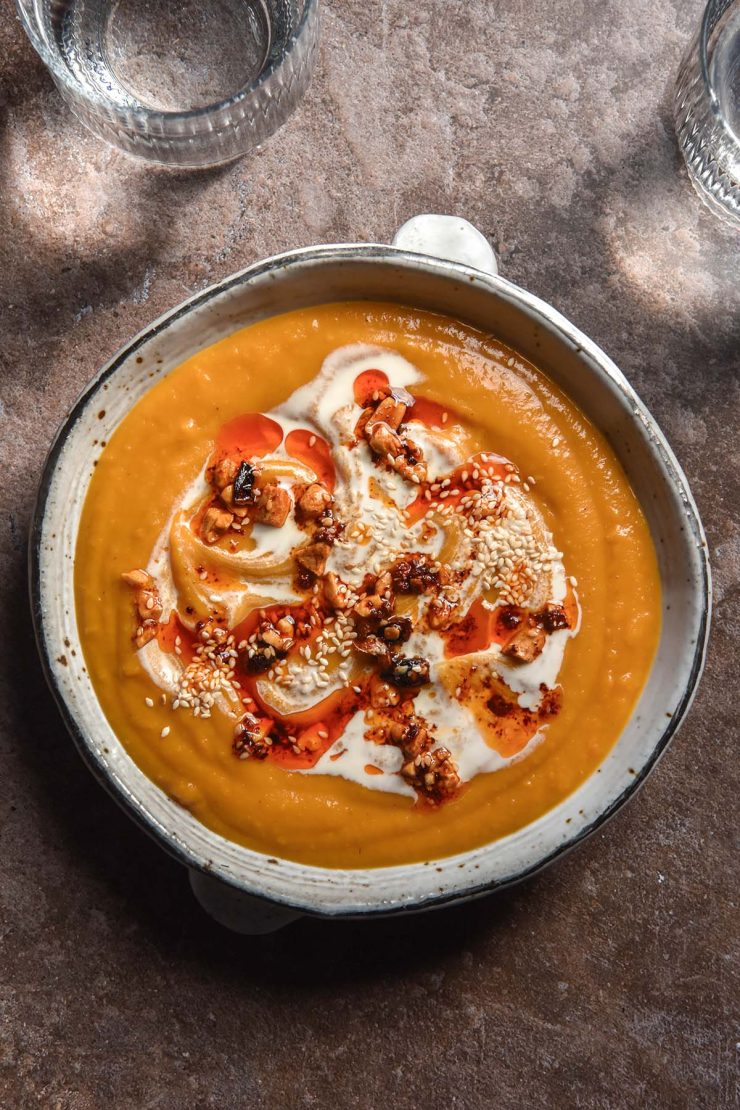
A while ago I promised that I would post a new pumpkin soup recipe in response to Monash lowering the FODMAP threshold for Kent pumpkin. Previously, Monash specified that Kent/Japanese pumpkin was a low FODMAP variety that could be eaten with near reckless abandon. Sadly, they have dramatically lowered the threshold of a low FODMAP serve. Fear not, though: this recipe for low FODMAP pumpkin soup uses a few nifty tricks to get around this inconvenient little detail.
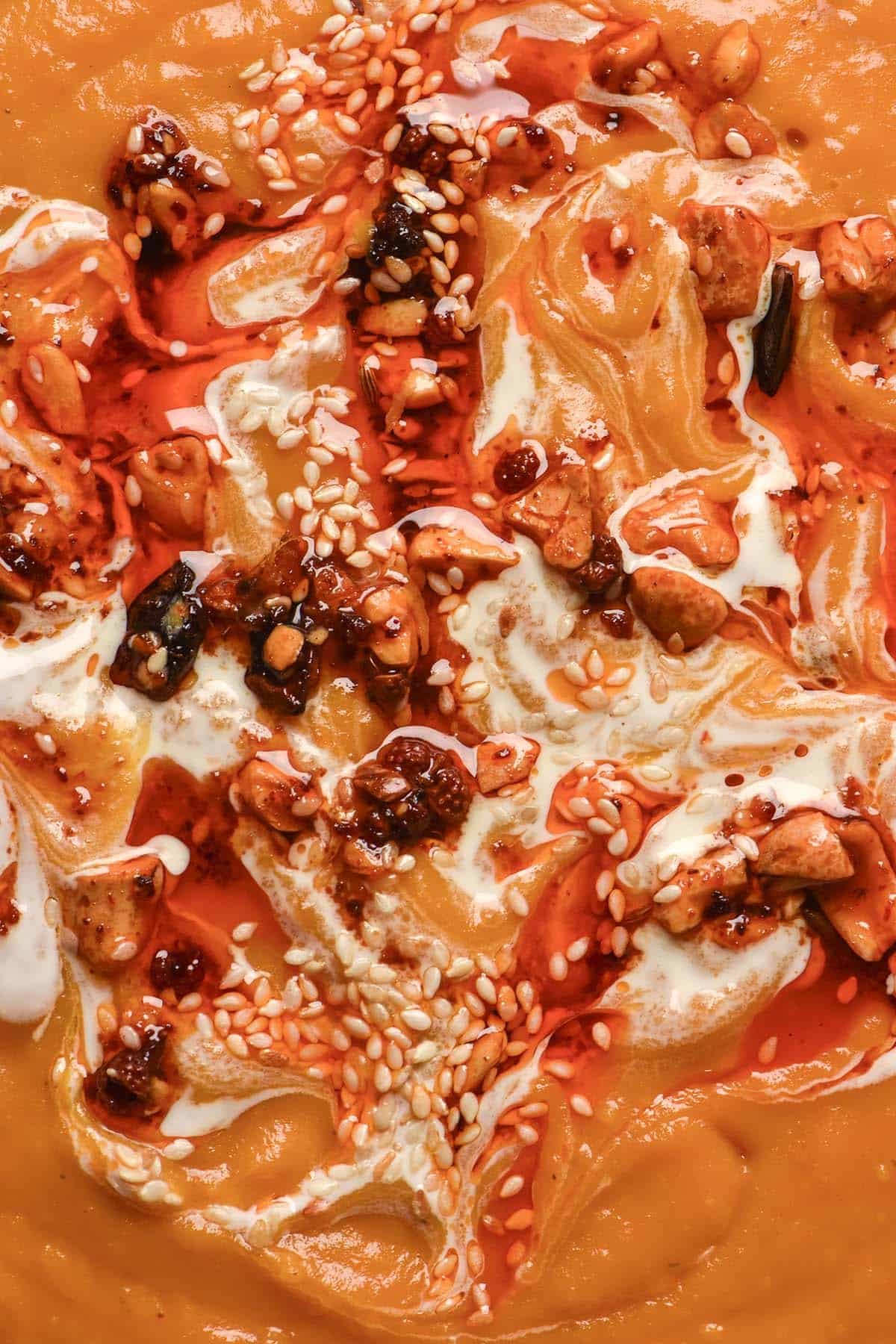
Low FODMAP pumpkin soup
Unlike my original recipe for FODMAP friendly pumpkin soup, this recipe uses more than just pumpkin. Because we need to keep the pumpkin to an affixed quantity, we are recruiting a few other vegetables.
Firstly, a little bit of sweet potato is added for sweetness, viscosity and colour. Carrot can also be added, but it needs to be kept to a minimum or it starts to overpower the pumpkin.
The true hero of the today, though, is potato. We’re using Sebago potatoes (aka all rounder potatoes in Australian supermarkets) to replace bulk in a low FODMAP way.
The soup base uses ginger for flavour and depth. You can use a homemade low FODMAP stock (I have a recipe here) or low FODMAP stock cubes for the broth component.
Finally, the finishing touches! Plenty of seasoning is all that is required, but you can add a bit of natural peanut butter, cream or coconut cream to finish. Anything goes.
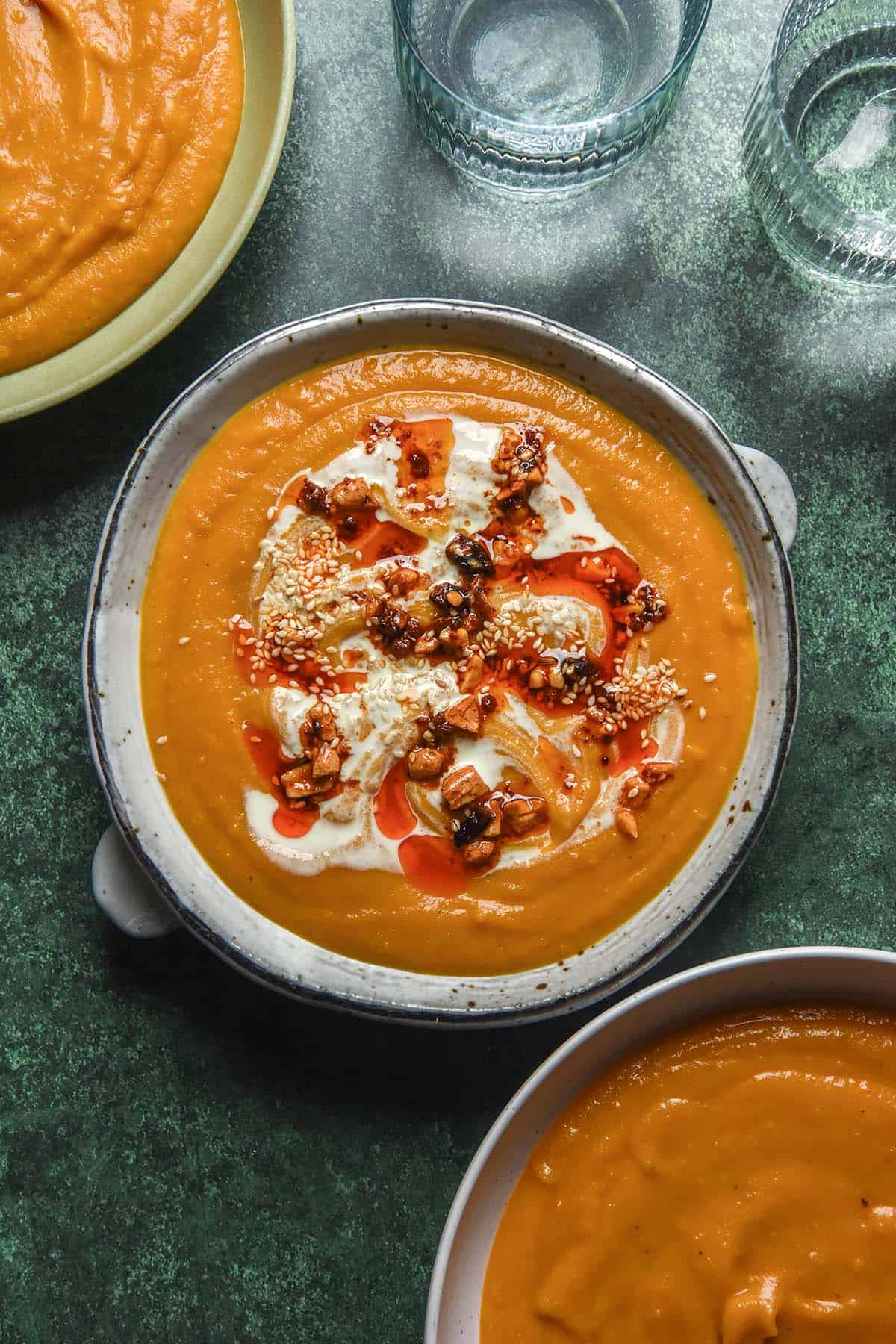
Tips for your low FODMAP pumpkin soup
The types of pumpkin and potato you buy matter, for different reasons. The variety of pumpkin needs to be Japanese/Kent or kabocha squash for FODMAP reasons (more below).
The variety of potato you use needs to be an all rounder or a starchy potato. I have only tested Sebago potatoes here (they are an all rounder variety). The variety of potato is critical to achieving the right texture, as it is with any potato soup. If you choose a waxy potato, it won’t create a nice velvety consistency like starchy and all rounder varieties.
Too many carrots will overpower the pumpkin flavour and take the soup in a carrot direction. I recommend keeping them to a minimum for the most convincing result.
If you finish your soup and find it’s a bit too potato soup like in texture, I have a little trick. Take a portion of the soup and blend it! Potatoes turn into a thicker, almost gluey consistency when blended. This helps give the soup a more cohesive, thick pumpkin soup consistency. You can experiment with blending more (I have done up to half) but don’t blend it all. I also only recommend blending it briefly, as potatoes can really glue up after a sustained blend.
One last thing: if you are using a blender without a steam valve (like a NutriBullet) you will need to allow it to cool first. Heat in an enclosed space will build up gas and could break or explode your NutriBullet. Hot soup all over the kitchen roof? No thanks.
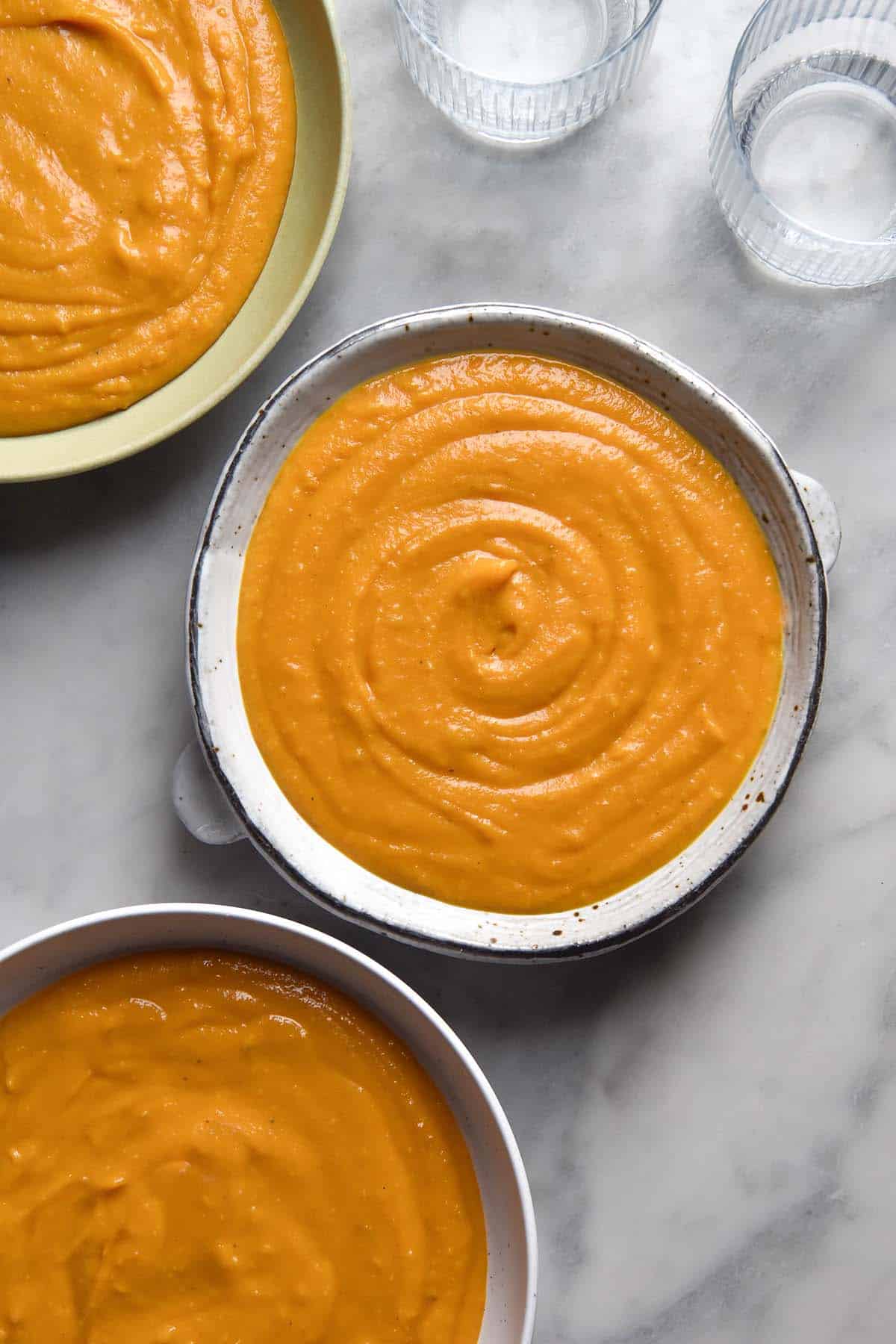
Do I have to roast the vegetables prior to making the soup?
You don’t have to, but it does add an extra layer of complexity and sweetness that might be missing without all the extra pumpkin.
I have tested both versions and they are both delicious. I did find, though, that the un-roasted version was less sweet and benefited from 40-60ml maple syrup to replace the sweetness of the pumpkin. I realise some people might not want to add sweetener to soup, and if you are one of those people I recommend roasting the vegetables.
A note on this, though: I haven’t roasted the potatoes with the other vegetables. A quick Google tells me that lots of soup recipes use roasted potatoes, but I left them out. I wondered if would affect the starch content or how they bring the soup together. It could work, I just haven’t tested it.
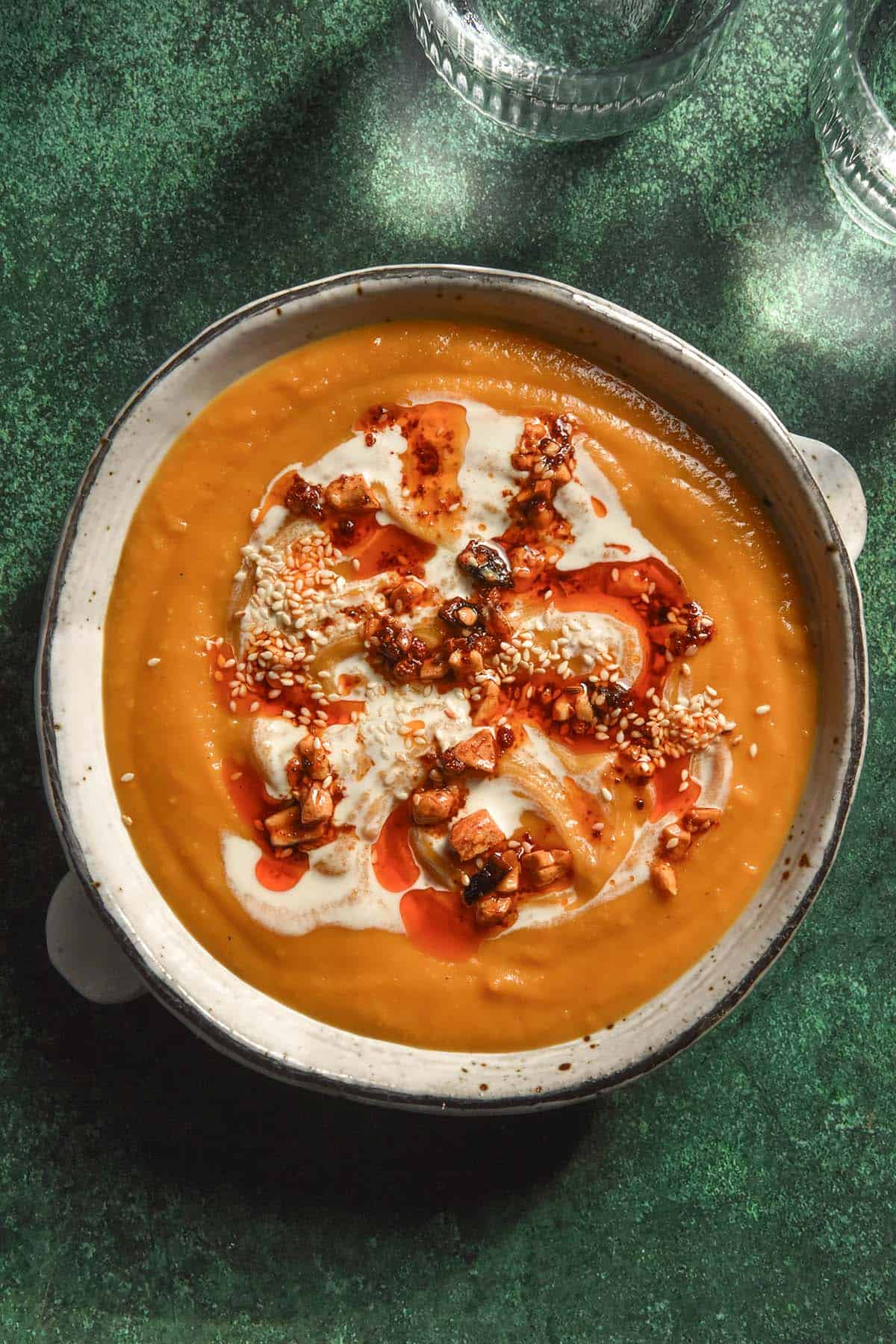
FODMAP notes
These FODMAP notes are current as of June 2025 and will be periodically reviewed and updated.
As we have discussed, the pumpkin you need for this soup is Kent/Japanese pumpkin. This is the same as Kabocha squash. This variety of pumpkin is low FODMAP in serves of 161g or less. In serves of 162g or more, it contains moderate amounts of fructans.
The soup uses 640g of pumpkin. While this might seem like a very specific amount, that is for FODMAP purposes. Using 640g pumpkin for a soup that serves 4 means you are consuming approximately 160g pumpkin per serve.
This is right up against the threshold of what constitutes a low FODMAP serve. If you know you are super reactive to fructans, you might consider using a bit less pumpkin and a bit more potato. If you do that, I recommend adding a bit of maple syrup to add that caramel sweetness that roasted pumpkin provides.
Interestingly, FODMAP Everyday has quite different FODMAP thresholds for pumpkin. I only recently downloaded their app (after I developed this recipe) but I thought the information might be helpful to include.
FODMAP Everyday say that Kent pumpkin is low FODMAP in serves of up to 94g when cooked. They offer more generous servings for Queensland Blue pumpkin (214g serves) and Butternut pumpkin (214g serves). If you react to Kent pumpkin, it might be worth considering testing your tolerances with these pumpkin varieties.
More FODMAP notes
According to Monash, orange sweet potato is low FODMAP in 75g serves. In 150g serves, it contains moderate amounts of fructan. The soup uses 150-200g sweet potato, which is comfortably under a low FODMAP threshold. However, it is worth noting that pumpkin is also fructan containing, according to Monash.
FODMAP Everyday, again, have a very different entry. They specify that orange sweet potato has no FODMAPs detected. See what works for you and your digestive system when determining which threshold aligns with your needs.
Choose a low FODMAP stock to keep the FODMAP content down. In terms of the optional finishing touches, choose a lactose free cream or milk or full fat coconut cream for low FODMAP options.
Peanut butter, the last optional mix in (which makes soup SO CREAMY) is low FODMAP in 50g serves. Monash doesn’t currently give an upper or lower limit. Interestingly, USA peanut butter only has a low FODMAP threshold of 32g (again, no upper or lower limit).
FODMAP Everyday lists peanut butter as being low FODMAP in serves of up to 167g.
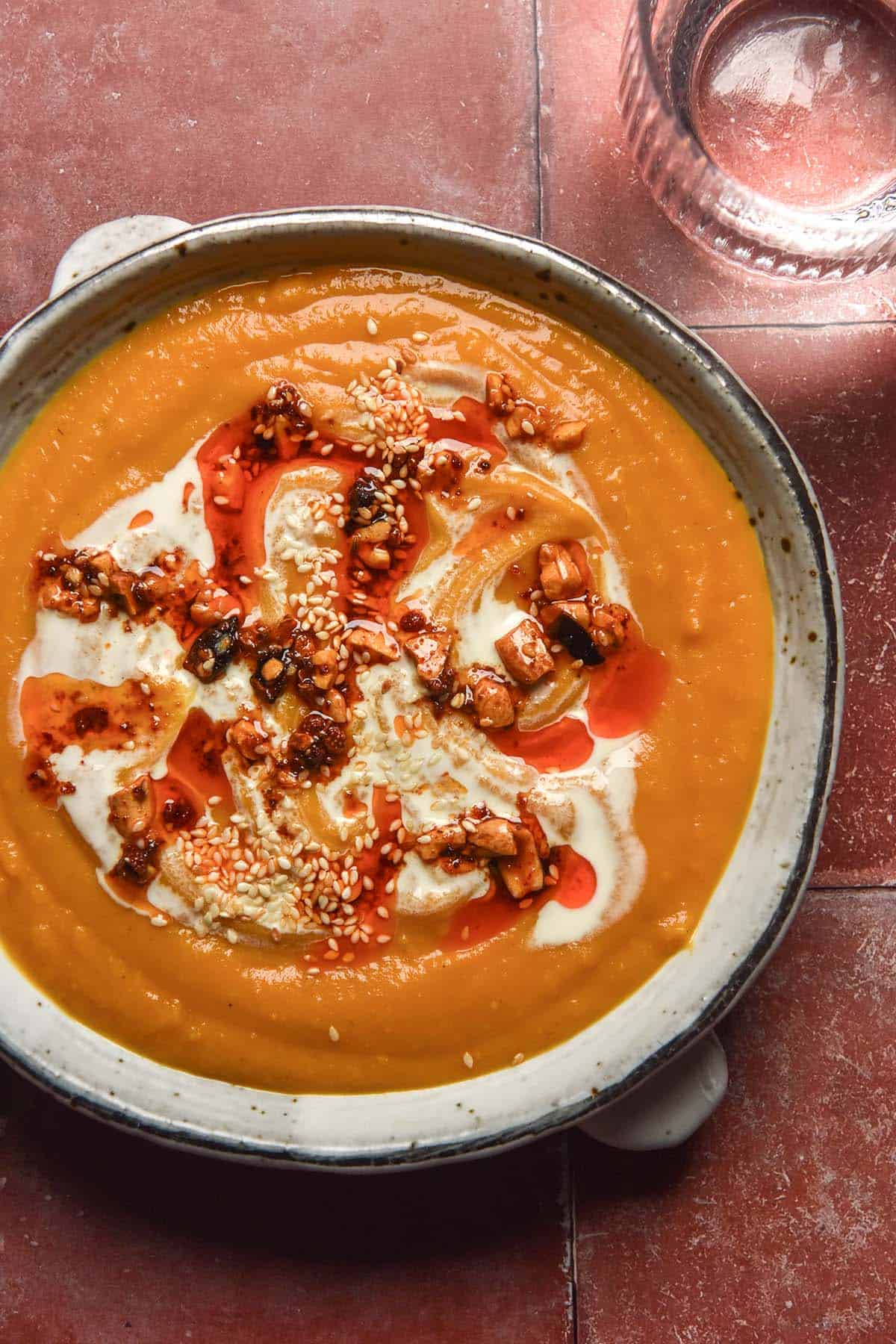
More low FODMAP soup recipes
- Low FODMAP leek and potato soup
- Low FODMAP minestrone soup
- Low FODMAP broccoli cheddar soup
- Low FODMAP carrot soup
- Low FODMAP lentil soup
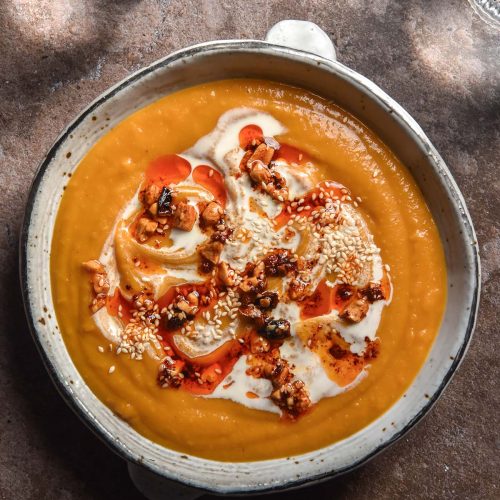
Low FODMAP pumpkin soup
Ingredients
For the low FODMAP pumpkin soup:
- 640 g Kent/Japanese pumpkin or Kabocha squash weighed after removing the skin (see notes)
- 150-200 g sweet potato weighed after peeling
- 100 g carrot weighed after peeling (optional)
- 600 g all rounder or starchy potato weighed after peeling (see notes)
- 40-60 ml (2-3 tablespoons)* oil of choice I used olive oil
- 20-40 g ginger finely chopped or grated
- 750-1000 ml+ low FODMAP stock as needed
- 20-60 ml (1-3 tablespoons)* pure maple syrup only as needed (brown sugar will also work)
- Seasoning to your tastes
Optional finishing ingredients:
- 2 tablespoons natural smooth peanut butter
- 2 tablespoons coconut cream or lactose free cream/sour cream
Instructions
Roasting option:
- Preheat the oven to 200C/400F. Chop the weighed pumpkin, sweet potato and optional carrot into bite size chunks and arrange them on a baking tray. Drizzle with 20-40ml (1-2 Australian tablespoons) of oil and use your hands to massage it in and coat each vegetable. This will ensure they don’t stick. Roast for 20-30 minutes or until cooked through and lightly golden.
To make the soup (applies to both roasted or non roasted options):
- Chop all the vegetables into bite sized pieces of a roughly even size, if you haven’t already.
- Heat the 40-60ml oil in a large soup pot over a medium heat. Once shimmering, add the chopped ginger and cook for a minute or so until fragrant. Stir frequently to prevent it sticking.
- Add the vegetables and stock to the pot and stir to combine. I like to add stock conservatively to start, then add more as I assess the consistency later.
- Place the lid on and cook for around 15-25 minutes or until all the vegetables are thoroughly cooked through. This will depend on whether you roasted the vegetables, how finely you chopped them and the heat you are using. Stick a knife through the largest piece of potato to confirm the vegetables are cooked through. It is important that the potatoes are fall apart tender to ensure they blend nicely into the soup.
- Use an immersion blender (soup stick) to blend the soup until smooth. Add the seasoning to taste, followed by maple syrup or brown sugar if the soup isn’t quite sweet enough. When you are happy with the taste, stir in any finishing ingredients you plan to use (they are optional).
- If you find the soup has a potato soup consistency, take a portion and blend it briefly (in a food processor or high powered blender, not just with the soup stick). This will change the starch molecules in the potato and give the soup a thick and creamy texture. Experiment with how much you blend, but do if briefly and don’t blend the entire batch of soup. If you have a blender without a steam valve, you will need to blend the soup after it cools.
- Store leftovers in an airtight container in the fridge. They will thicken a little, so add a splash of milk or water to the thin the leftovers to your desired consistency if needed.
Notes
- Potato based soups really need a soup stick for blending. A food processor will smash the starch molecules in a potato and create a gluey texture. This is fine for a portion of our soup, but not for a whole batch.
- Read the FODMAP notes in the body of the post.
- Read the tips in the body of the post.
- 640g pumpkin equates to 160g pumpkin per serve (approximately). You can experiment with adding less pumpkin to lower the fructan content further. See the notes in the body of the post for advice on doing this.

This recipe was fantastic!